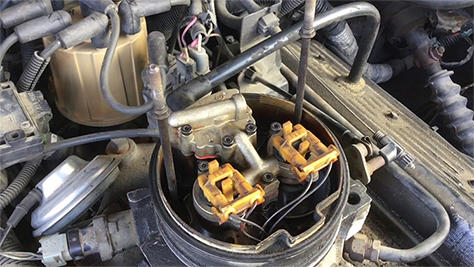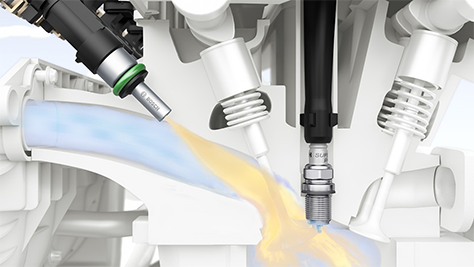
We should first start with “What makes direct fuel injection different from other forms of fuel injection?” Fuel injection systems in gasoline engines have evolved over the years due to the constant search for increased fuel economy and reduced exhaust emissions. Many of the improvements coincide with the increased computing power of the Engine Control Module

(ECM) aka engine computers. Beginning early in the ‘80s, Throttle Body Fuel Injection (TBI) was introduced as a more precise way to deliver fuel compared to carburation. TBI systems boasted improved cold starting, better throttle response, improved power, and the ability to adapt to different elevations and operating conditions. TBI systems use one to four fuel injectors in a central location in the intake manifold and the fuel is drawn into each cylinder when the intake valves open. The next step in fuel delivery was Port Fuel Injection (PFI), which moves the fuel injectors closer to the intake valve of each cylinder. One fuel injector per cylinder. The early systems would fire a bank of fuel injectors at a time. Which is still an improvement over TBI systems but, still not as precise as it could be. As the computing power of ECMs improved they were able to handle more sensor inputs and could make faster and finer adjustments to the fuel delivery system. They started to time the fuel injector sprays to each intake valve opening aka Sequential Fuel Injection. More control, more precision equals improved efficiency and reduced emissions. Gasoline Direct Injection (GDI) systems take the next step and inject fuel directly into each cylinder, which is how most Diesel engines deliver fuel in their engines. Depending on the engine design, the injection event will occur during the intake stroke and sometimes during the compression stroke. By directly injecting the fuel into the cylinder, the Powertrain Control Module (PCM), (faster and more powerful than the ECM), can tune the fuel mixture to the needs of that cylinder under any given load. Promoting the most efficient combustion of the delivered fuel, thereby maximizing power output.
Key Components of GDI Systems
Powertrain Control Module (PCM) with powerful microprocessors and sophisticated software.
High pressure fuel delivery system. Most systems have a low-pressure lift pump in the tank and a high-pressure pump on the engine that is capable of fuel pressures near 3000 PSI.
Fuel Injectors. GDI Fuel injectors can deliver a precise fuel charge at high pressure. Delivering fine fuel droplets to the cylinder for maximum fuel atomization.
Forced Induction. While forced induction (Turbos or Superchargers) are not required for GDI operation, they are a very common component used to maximum performance and efficiency from smaller displacement engines.
Advantages of GDI Systems
Improved Fuel Efficiency. GDI improves fuel efficiency by delivering a precise, fine droplet fuel change, allowing for better combustion and reduced fuel wastage.
Enhanced Performance. GDI contributes to improved engine performance, delivering more power and torque, particularly at lower RPMs.
Reduced Emissions. The precise control over the combustion process helps reduce harmful emissions, making GDI systems an eco-friendly technology.
Faster Throttle Response. GDI systems offer quicker throttle response and smoother acceleration, enhancing the overall driving experience.
Challenges of GDI Systems
Carbon Build-up. The most common problem associated with GDI engines is carbon build-up on the valves, fuel injectors, and pistons. Which can create poor drivability and cylinder misfires. This is one area where PFI systems have an advantage over GDI systems. PFI systems deliver fuel at lower pressure to the back of the intake valves, which has a cleaning effect on the valves and reduces carbon build-up.
Timing Chain Wear. Several factors contribute to this problem. Soot formation from unburnt fuel washed down the cylinder walls and pushed into the engine oil from cylinder blow by. Which floats around in the oil and wears down the pin holes in the timing chain. Which can be accelerated by extended or overdue oil changes.
Fuel Dilution. Mainly from unburnt fuel making it down into the oil from the problem described above. Magnified by short trips with the vehicle engine not at operating temperature.
Low Speed Pre-Ignition. When the fuel mixture begins to burn at the wrong time before the intended ignition point (aka engine knock). Usually occurs at low engine RPM at high engine load. Carbon build-up can create hotspots in the cylinder that increase the likelihood of this problem. Severe engine damage can occur if engine knock is not managed.
GDI Maintenance Requirements
Maintenance is the key to keeping your GDI equipped vehicle operating at peak efficiency and performance!
Air Induction Cleaning Service every 15,000 miles. Cleaning your air induction system regularly, with the right chemicals, dissolves carbon deposits and keeps the air flowing smoothly into each cylinder, maintaining efficiency. General Motors has recently approved this cleaning process for all their GDI engines, and they are now mandating it as part of their recommended maintenance schedules.
Fuel Injector Cleaning Service every 30,000 miles. Done in conjunction with the Air Induction Cleanings keeps the fuel injectors spraying properly and keeps the carbon deposits from accumulating on the pistons and in the piston ring grooves.
Regular and Consistent Oil Changes using the Correct Oil. GDI engines are hard on oil. The oil in these engines are required to do more work, which breaks the oil down faster. Regular oil changes remove contaminants. Using the correct oil is key to maintaining the longevity of these engines.
Top Tier Quality Fuel. It is essential to use high-quality fuel that contains detergents and additives to prevent carbon buildup. Premium or top-tier gasoline is recommended as it typically contains a higher level of cleaning agents. Engines using forced induction may also require higher octane fuel. Consult the vehicle owner’s manual for more vehicle specific information.
Keep an Eye on Warning Signs. Be vigilant for any warning signs of GDI engine problems, such as rough idling, reduced fuel efficiency, loss of power, or unusual engine noises. If you notice any of these issues, it’s essential to have your vehicle inspected by a qualified Automotive Service Technician to identify and address potential GDI system problems promptly.
Common Gasoline Engines with Direct Fuel Injection
Most vehicles produced from 2006 and up↑.
Ford EcoBoost engines
Volkswagen TSI engines
BMW TwinPower Turbo engines
General Motors Ecotec engines
Audi TFSI engines
Mercedes-Benz BlueDIRECT engines
Toyota D-4S engines
Honda i-VTEC engines
Direct fuel injection technology has transformed the automotive industry by improving fuel efficiency and engine performance. However, to enjoy the benefits of GDI engines, it’s essential to stay diligent with maintenance requirements. Regular Air Induction System Services, Fuel Injector Cleaning Services, using high-quality fuel, and regular oil changes are key to ensuring your GDI system functions at peak performance. By staying proactive and informed, you can keep your vehicle’s engine running smoothly for years to come.
Aaron B.